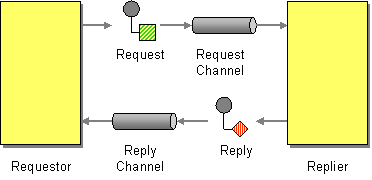Request Reply
Camel supports the Request Reply from the EIP patterns by supporting the Exchange Pattern on a Message which can be set to InOut to indicate a request/reply. Camel Components then implement this pattern using the underlying transport or protocols.

For example when using JMS with InOut the component will by default perform these actions
- create by default a temporary inbound queue
- set the JMSReplyTo destination on the request message
- set the JMSCorrelationID on the request message
- send the request message
- consume the response and associate the inbound message to the request using the JMSCorrelationID (as you may be performing many concurrent request/responses).
Explicitly specifying InOut
When consuming messages from JMS a Request-Reply is indicated by the presence of the JMSReplyTo header.
You can explicitly force an endpoint to be in Request Reply mode by setting the exchange pattern on the URI. e.g.
| Code Block |
|---|
jms:MyQueue?exchangePattern=InOut
|
You can specify the exchange pattern in DSL rule or Spring configuration.
| Wiki Markup |
|---|
{snippet:id=example|lang=java|url=camel/trunk/camel-core/src/test/java/org/apache/camel/processor/SetExchangePatternTest.java} |
| Wiki Markup |
|---|
{snippet:id=example|lang=xml|url=camel/trunk/components/camel-spring/src/test/resources/org/apache/camel/spring/processor/setExchangePattern.xml} |
| Include Page |
|---|
| Using This Pattern |
|---|
| Using This Pattern |
|---|
|
